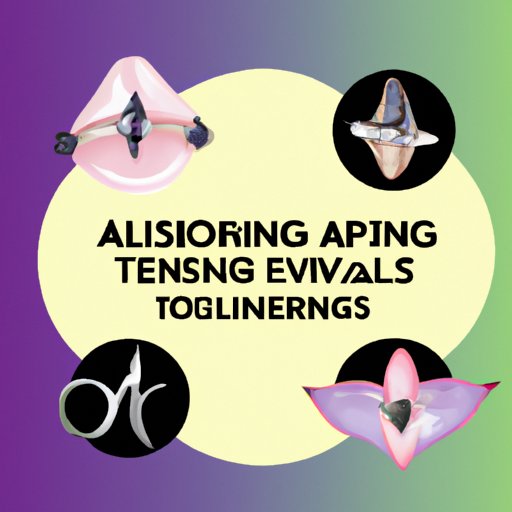I. Introduction
Nipple piercings are a form of body modification that have become increasingly popular in recent years. However, those considering getting this type of piercing should be aware that healing time can vary greatly depending on a number of factors. In this article, we will explore what affects the healing time of nipple piercings, offer tips for proper aftercare, bust some common misconceptions and potential risks, and share personal experiences and professional advice to aid in the healing process.
II. Top 5 factors that affect healing time for nipple piercings
While the healing process can be unpredictable, there are some factors that can help determine how long it will take:
Factor 1: Individual physiology
Everyone’s body is unique and will react differently to the piercing process and healing process. Some people may have no complications and heal quickly, while others may experience complications that prolong healing time.
Factor 2: Placement of the piercing
The placement of the piercing (horizontal or vertical) can also determine healing time. Horizontal piercings generally take longer to heal since they pass through more tissue.
Factor 3: Quality of aftercare
Consistent and proper aftercare is crucial for a successful and timely healing process. Neglecting proper cleaning and care instructions can lead to infections and prolong healing time.
Factor 4: Lifestyle choices
Poor diet, drug use, smoking and excessive alcohol consumption can all negatively impact the healing process. Alternatively, healthy choices like incorporating exercise, getting enough sleep, and managing stress levels can help speed up healing time.
Factor 5: Existing health conditions
Pre-existing health conditions like anemia, diabetes and compromised immune systems can prolong healing time or lead to complications. It’s important to consult with a medical professional prior to getting a nipple piercing if you have any underlying health concerns.
III. A guide to proper aftercare for nipple piercings to aid in healing
Proper aftercare is vital to avoid complications and avoid prolonging the healing process. Here are some tips to follow:
Cleaning and care instructions
Wash your hands before touching the piercing and clean it twice a day with saline solution or mild, fragrance-free soap. Rinse thoroughly and pat dry with a clean, disposable paper towel. Clean the area surrounding the piercing, making sure not to rotate or move it.
What to avoid during the healing process
Avoid submerging the piercing in pools or hot tubs, and avoid excessive exposure to sun or tanning beds. Do not touch or rotate the piercing, and avoid wearing tight clothing that may irritate the piercing.
Signs of infection and when to seek medical attention
Redness, swelling, yellow or green discharge, and fever are all signs of an infection. If you experience these symptoms, seek medical attention immediately.
IV. Common misconceptions about healing times for nipple piercings
There are a number of myths about healing times for nipple piercings that can be misleading or downright inaccurate.
Debunking myths about magical healing times
Despite what some may say, nipple piercings do not magically heal overnight or within a few weeks. Healing time can take anywhere from a few months to a year depending on the healing process and factors mentioned above.
The importance of individual differences
Because everyone’s body is different, there is no set timeframe for the healing process. Factors such as age, weight, and overall health play a role in the healing process and can impact healing times.

V. Expert advice: Tips from piercing professionals on how to promote healing
Getting insight from professional piercers can be helpful for better understanding how to promote a successful healing experience.
Insights from professional piercers
According to Sam Ramage, a professional piercer at Black and Blue Tattoo, “the initial healing period should take around six to eight weeks but it can take at least six months to completely heal. If there’s no pain, swelling or discharge, it should be good to change jewelry after six months”.
Different opinions on the best aftercare practices
There are different opinions on the best aftercare practices for nipple piercings. However, some professionals suggest using saline solutions instead of sea salt, while others recommend using soap and water. It’s important to follow the aftercare instructions recommended by the piercer and to consult with a professional with any questions or concerns.
VI. Personal experiences and timelines: A collection of stories from people who have had nipple piercings
Personal experiences can help provide insight on the healing process and give readers a better understanding of what to expect.
Quotes and stories from actual people who have gone through the healing process
“I got my nipple piercing just over a year ago and it took about 8 months to fully heal. Following the cleaning and aftercare instructions really helped it to heal quickly. I also made sure to avoid anything that would irritate the piercing.” – Samantha, 23
“I had both of my nipples pierced earlier this year and they are still healing. I noticed a lot of progress in the first few months, but they are still sore and occasionally release discharge. I know they are healing and just need to continue to be patient!” – Cooper, 29
Highlight variations of healing time from the individuals’ experiences
From Samantha’s experience, her nipple piercing healed in 8 months, while Cooper is still in the healing process. This shows that healing time can vary depending on the individual and factors mentioned above.
VII. The effects of lifestyle choices on healing times for nipple piercings
Lifestyle choices can impact healing times for nipple piercings, both positively and negatively.
Factors that can negatively and positively impact healing time
Factors such as smoking, drug use, and excessive alcohol consumption can negatively impact the healing process. On the other hand, eating a healthy diet, exercising, and managing stress levels can promote faster healing.
Encouraging healthy choices to aid in healing time
Encouraging healthy choices can be helpful when going through the healing process. This can include making sure to eat nutritious foods, avoiding smoking and excessive drinking, and staying active.
VIII. Risks and complications to watch for during the healing process for nipple piercings
There are possible risks and complications when going through the healing process.
Possible risks and complications
Infections, keloids, allergic reactions, and scarring are all possibilities when getting nipple piercings. It’s important to pay close attention to the healing process and to seek medical attention if any complications arise.
How and when to seek medical attention
If you experience any signs of infection or are concerned about any other complications, it’s important to seek medical attention immediately.
IX. Conclusion
Overall, healing time for nipple piercings can vary greatly, and there’s no “magical” way to speed up the process. Proper care and attention, as well as healthy lifestyle choices, can help promote healing in a timely manner. It’s important to consult with a professional piercer and to pay attention to the individual factors that can impact healing time. Keeping informed and mindful of the healing process can help ensure a successful and comfortable experience.
